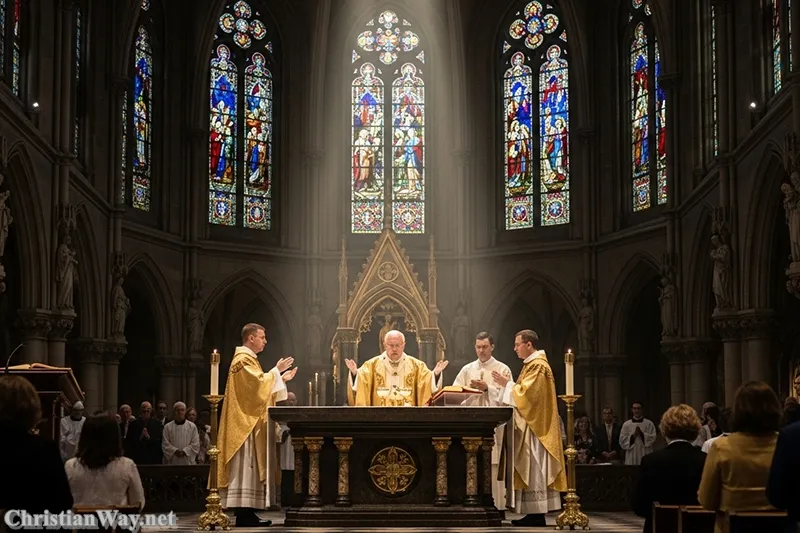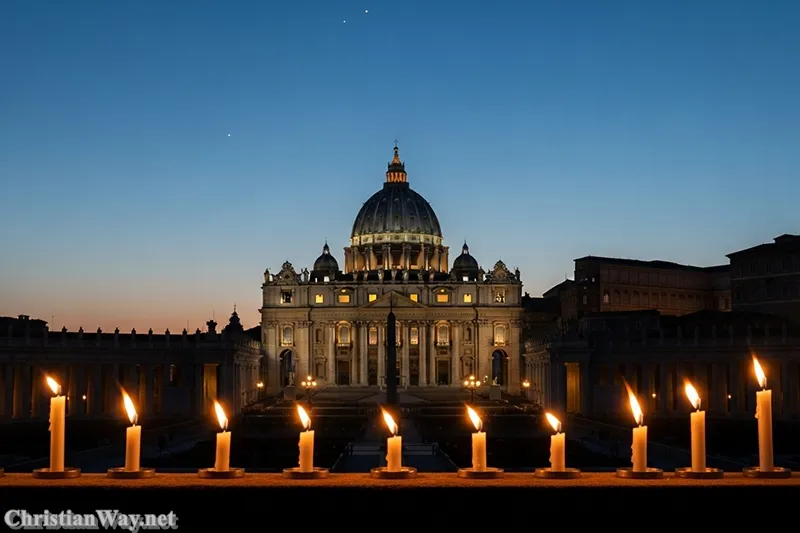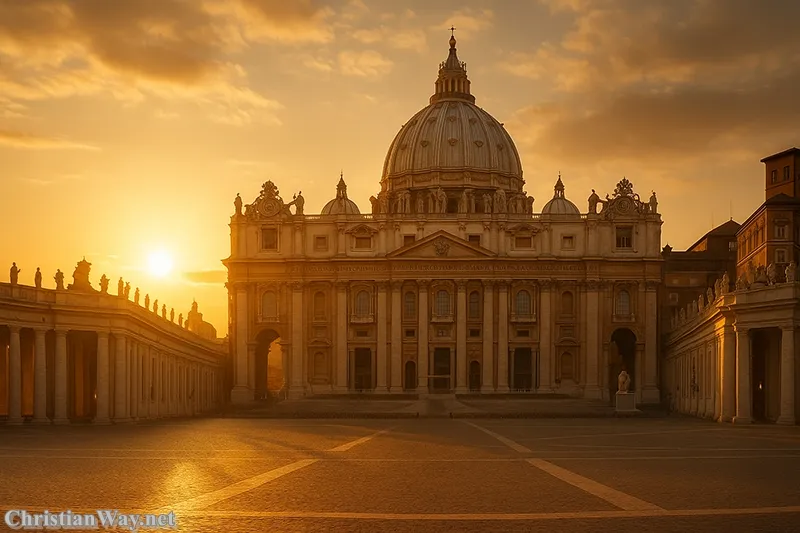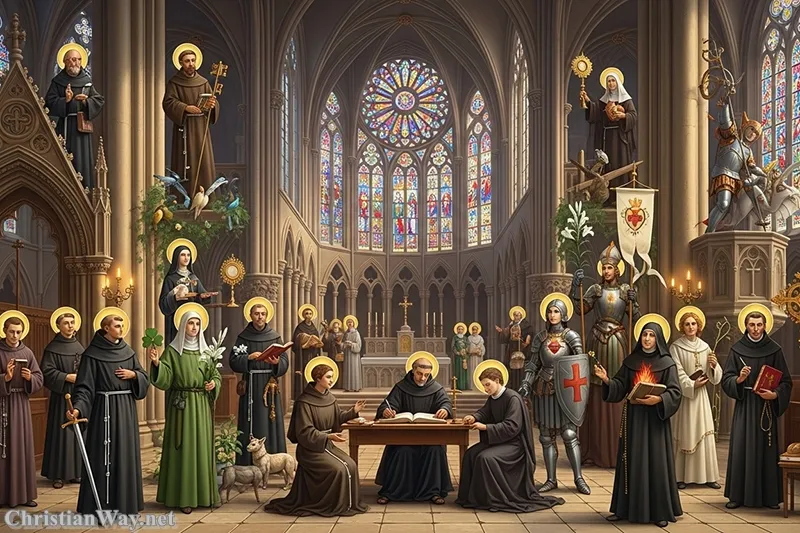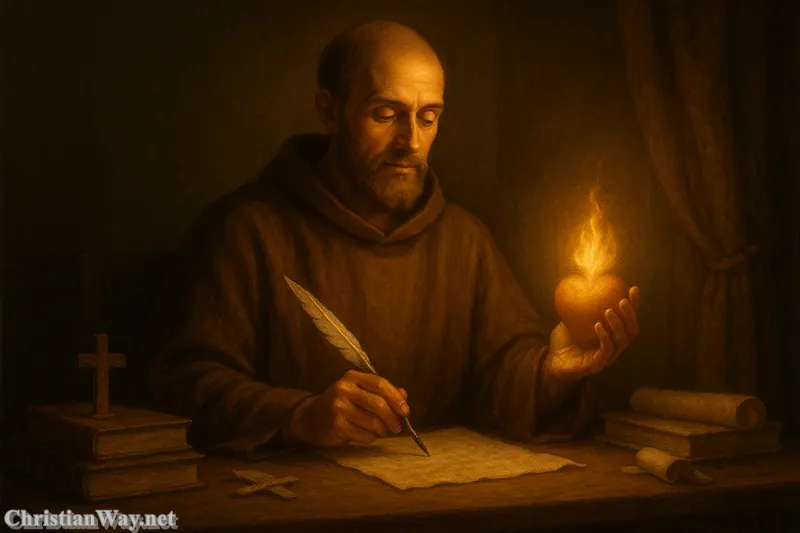Dear friends in Christ,
There are lives that shape centuries, not through power or conquest, but through prayer, silence, and holiness. Among them stands Saint Benedict of Nursia, a man whose quiet obedience to God gave rise to a movement that preserved faith, learning, and culture through the darkness of history.
In a time when the Roman world was collapsing, Benedict built something eternal — not cities or armies, but a way of life centered on Christ, prayer, and community. His Rule of St Benedict, written in the 6th century, became the cornerstone of Western monasticism, guiding monks, nuns, and laypeople for over 1,500 years.

He did not set out to reform the world; he sought only to serve God faithfully. Yet through his humility and vision, he became the patron saint of Europe and the spiritual father of countless souls.
His legacy endures in the simplicity of his motto:
“Ora et labora” — Pray and work.
It is a phrase that unites heaven and earth, contemplation and action, showing us that holiness is not found in escape from the world, but in sanctifying every moment of life.
The Early Life of Saint Benedict of Nursia
From youth to solitude
Saint Benedict of Nursia biography begins around the year 480 A.D., in Nursia (modern Norcia, Italy). Born into a noble Roman family, Benedict was sent to study in Rome — but there he found not wisdom, but corruption. The city’s moral decay troubled his soul deeply.
Seeking purity and peace, he left behind his studies, his wealth, and his future, retreating to the countryside to live for God alone.
He first dwelled in a small cave near Subiaco, where he lived as a hermit for three years. There, guided only by prayer and fasting, he began the lifelong journey of conversion.
Yet even in solitude, his light drew others. People sought him for counsel, for healing, and for the peace that radiated from his soul.
From that hidden beginning, God raised up a movement that would renew the Christian world.
The Call to Community — The First Monasteries
From solitude to brotherhood
As disciples gathered around him, Benedict founded small communities of monks near Subiaco. Each group lived under a simple structure of prayer, work, and common life.
But as the number of followers grew, so did opposition. Some monks, unable to bear his discipline, even tried to poison him — yet when Benedict blessed the cup, it shattered, and he was unharmed.
Undeterred, he moved to a new mountain in Monte Cassino, where he built the monastery that would become the heart of the Benedictine Order.
From this mountain, his light spread through Europe, shaping not only monastic life but the entire Christian civilization that followed.
The Rule of Saint Benedict — A Path of Balance and Grace
The heart of Benedictine spirituality
The Rule of St Benedict is one of the most influential spiritual texts in history. Written with fatherly wisdom and humility, it offers a guide for living a life of stability, obedience, and moderation.
It was not written only for monks, but for all who seek holiness in daily life.
Benedict understood that holiness is built not on great deeds but on faithfulness in small things. His Rule unites prayer and work, silence and community, humility and service. It begins with these simple words:
“Listen, my son, to the precepts of the master, and incline the ear of your heart.”
This call to listen — to God, to others, to one’s own conscience — is the foundation of all spiritual growth.
The Rule of St Benedict summary can be seen in three key virtues:
- Obedience — The readiness to hear and respond to God’s will.
- Stability — The faithfulness to one’s community and vocation.
- Conversion of life — The continual turning of the heart toward holiness.
Through these, the Rule creates not a rigid system, but a living school of love — where the goal, as Benedict writes, is that “our hearts may be enlarged to run in the way of God’s commandments with joy.”
The Motto: “Ora et Labora” — Pray and Work
A vision for all Christian life
The phrase “Ora et labora” captures the essence of St Benedict spirituality. It reminds us that prayer and work are not separate realms but two expressions of one love.
The monk prays in the chapel and works in the garden; the layperson prays in the heart while laboring in the world. Both are sanctified by the same spirit.
In an age of distraction, Benedict’s wisdom calls us to rediscover rhythm — moments of prayer that anchor our work, and labor that flows from devotion.
He teaches us that holiness is not achieved by fleeing the world but by filling it with God’s presence.
Saint Benedict’s Miracles and the Cross
Signs of God’s power through His servant
Throughout his life, Saint Benedict of Nursia was known for miracles that revealed both God’s power and his humility.
One story tells of a broken sieve that he miraculously repaired for a peasant woman, a small act that drew many hearts to faith. Another recounts how he raised a dead child through prayer.
But perhaps the most famous symbol associated with him is the St Benedict cross and the St Benedict medal, known as powerful sacramentals against evil.
The medal bears the initials of a Latin prayer of exorcism and protection:
“Vade retro Satana” — “Begone, Satan.”
It reminds the faithful that the power of Christ’s Cross conquers every temptation and that faith, when lived with obedience, defeats all evil.
Through his intercession, St Benedict protection medal continues to bless countless homes, travelers, and believers seeking spiritual strength.
Saint Benedict and Monte Cassino
The cradle of Western monasticism
At Monte Cassino, Benedict built more than a monastery; he built a model of Christian life that balanced prayer, study, and labor.
From this place, the Benedictine Order spread throughout Europe, preserving Scripture, art, and learning during the centuries that followed the fall of Rome.
Monasteries became centers of education, hospitality, and charity — quiet fortresses of light amid the world’s darkness.
Even when Monte Cassino was destroyed — first by invaders, later by war — it was always rebuilt. Like faith itself, it could not be silenced.
Benedict’s legacy endures wherever people seek God through community, silence, and work.
The Spiritual Vision of Saint Benedict
Humility, peace, and order
Benedict’s genius was not in invention but in integration. He united heaven and earth through a vision of peace — Pax, the Benedictine motto meaning “peace.”
His spirituality centers on humility — seeing oneself truthfully before God — and on order, which brings harmony to both soul and community.
In the Rule, he writes:
“Prefer nothing whatever to the love of Christ.”
These words capture the essence of Christian life: that every choice, every prayer, every act of work should flow from love for Christ above all else.
Through this simplicity, Saint Benedict teaches the modern soul how to find peace in chaos, prayer in busyness, and meaning in every moment.
Saint Benedict as the Patron Saint of Europe
A father to nations and hearts
In 1964, Pope Paul VI declared Saint Benedict the patron saint of Europe, honoring his role in shaping the continent’s Christian identity.
Through the monasteries inspired by his Rule, faith, culture, and education were preserved during centuries of turmoil. Monks copied manuscripts, cared for the poor, and kept alive the light of the Gospel.
Benedict’s influence extended beyond monasteries — his spirit of discipline, prayer, and service helped build the moral foundation of a Christian civilization.
As the modern world faces new confusion and division, his legacy calls us again to rebuild our hearts and homes on the same foundation: Christ alone.
The St Benedict Medal and Prayer of Protection
A weapon of faith
The St Benedict medal is one of the Church’s most beloved sacramentals, a visible sign of faith and a shield against spiritual danger.
On it are inscribed the initials of prayers invoking God’s protection through Saint Benedict’s intercession. Among them:
“Crux sacra sit mihi lux” — “May the Holy Cross be my light.”
“Non draco sit mihi dux” — “Let not the dragon be my guide.”
This medal is a reminder that spiritual warfare is real, but Christ’s victory is greater. It invites us to live each day under the sign of the Cross — with peace, humility, and trust.
The St Benedict prayer continues this devotion:
“Saint Benedict, faithful servant of God,
who taught the world the power of prayer and work,
protect us from all evil,
guide us in humility and peace,
and lead us safely to Christ.”
In every home where this medal or prayer is found, there rests a quiet echo of Benedict’s enduring peace.
Saint Benedict’s Death and Legacy
Dying as he lived — in prayer
Benedict’s death was as holy as his life. According to Saint Gregory the Great, he died standing before the altar, supported by his brothers, hands raised in prayer, just after receiving the Body and Blood of Christ.
He entered eternity as he had lived: in worship, surrounded by his community, eyes fixed on heaven.
His feast day, July 11, celebrates not only his life but his lasting influence — a reminder that holiness built in silence and discipline shapes the world more deeply than any empire.
Wherever the Benedictine Order continues to pray and serve, his spirit remains alive — teaching souls how to build a life founded on peace, order, and divine love.
Saint Benedict and the Modern Soul
A guide for restless hearts
In a noisy and hurried world, the spirituality of Saint Benedict speaks with fresh clarity. His wisdom invites us to create order in our days, silence in our hearts, and purpose in our work.
He calls us to find God not in constant activity but in attentive presence. To pray before we act, and to act as prayer.
Whether you are a monk or a parent, a student or a worker, his words apply:
“Let all be done so that God may be glorified.” (Rule, ch. 57)
Through this spirit, even the smallest duty becomes sacred. Every moment becomes an offering of love.
Lessons from the Life of Saint Benedict
1. Listen with the ear of your heart
Prayer begins in silence, and holiness begins in listening.
2. Seek balance in all things
True peace comes from harmony between work, prayer, and rest.
3. Build community with love
The monastery — or any home — thrives on mutual respect and service.
4. Prefer nothing to Christ
Faithfulness to God must come before all else.
5. Live under the Cross
The Cross is not a burden, but a blessing — the sign of victory and peace.
🕯️ Reflect and Pray
O Saint Benedict,
father of monks and teacher of holy life,
you left the world to seek God in prayer and solitude,
and in doing so, you became a light for all generations.
Teach us to prefer nothing to the love of Christ.
Guide us to live with peace, humility, and discipline.
Protect us with your blessed medal,
and help us to carry the Cross with courage and joy.
Pray for our homes, our work, and our hearts,
that we may live every day under God’s blessing
and find eternal rest in His mercy.
Saint Benedict of Nursia,
pray for us.
Amen.
May the wisdom of Saint Benedict guide your days
and the peace of his Rule dwell within your heart.
— Fr. John Matthew, for Christian Way
